Bulletin – December 2010 Developments in Utilities Prices
Abstract
Large increases in the prices of utilities have been a notable feature of consumer price inflation in Australia in recent years, and further large increases are anticipated over the next few years. The recent price rises reflect the move towards cost-based pricing, the need to replace and expand infrastructure to meet demand, and rising input costs. At times, these increases in utilities prices have had a significant effect on aggregate inflation. While international comparisons are not straightforward, the level of electricity and gas prices in Australia does not, however, appear to be particularly high compared with prices in a number of other advanced economies.
Introduction
Utilities prices have been one of the fastest growing sub-groups of the consumer price index (CPI) in recent years, and further large increases are anticipated over the next few years. This article discusses developments in utilities prices, including some aspects of market structure and pricing, and the reasons for the recent large price increases. The implications for inflation in Australia are also examined. While international comparisons are not straightforward, some attempt is made to compare the level of electricity and gas prices across a number of advanced economies.
Developments in Utilities Prices
In the CPI, utilities comprise electricity, gas & other household fuels, and water & sewerage. The prices of utilities have increased strongly in recent years, with the pace of inflation reaching 15 per cent over the year to June 2010, before moderating a little recently (Graph 1). These increases follow subdued price rises during most of the 1990s. Given that utilities have an effective weight of more than 4 per cent in the CPI, the recent pick-up in utilities price inflation has had a significant impact on aggregate inflation.
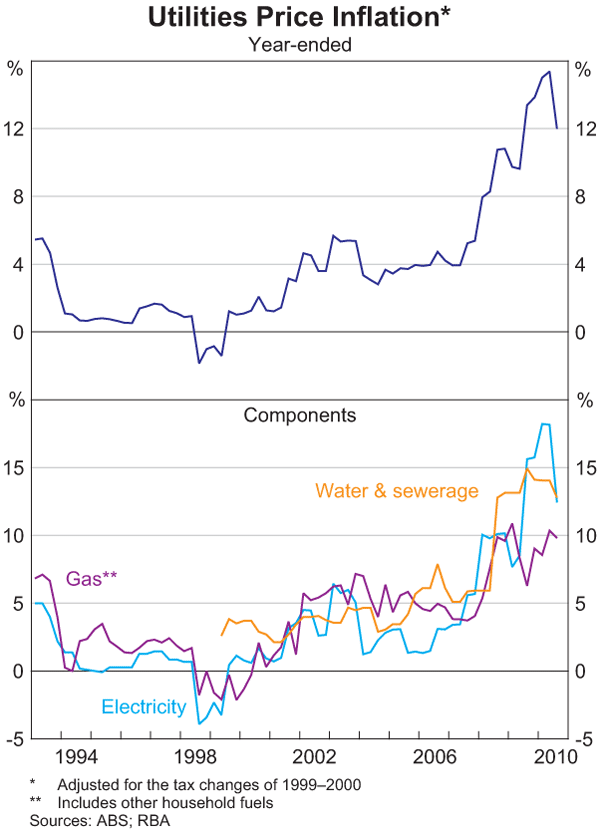
The large price increases in recent years have been broadly based across the different utilities. Over the past year, electricity and water & sewerage prices in the CPI both increased by more than 12 per cent, while the price of gas & other household fuels rose by nearly 10 per cent (Table 1). By comparison, the CPI excluding utilities increased by 2½ per cent over the past year. All capital cities have recorded strong increases in utilities prices over the past decade, even though prices are generally set independently across the states, with the largest increases recorded in the east coast capital cities (Graph 2).
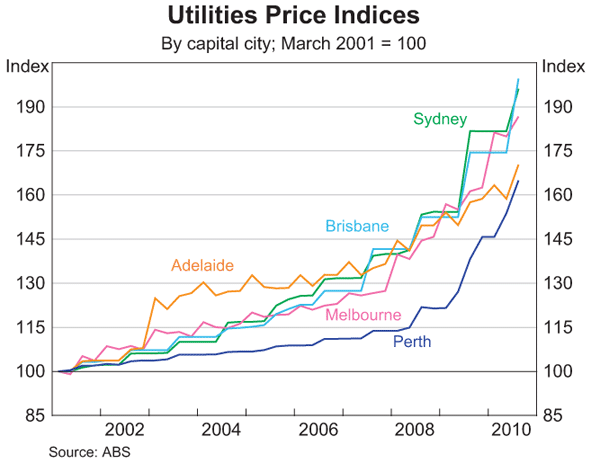
| Effective weight | Inflation over the year |
Inflation over the previous five years (annualised) |
|
|---|---|---|---|
| Utilities | 4.2 | 12.0 | 7.5 |
| of which: | |||
| Electricity | 2.2 | 12.4 | 7.3 |
| Gas(a) | 0.9 | 9.8 | 6.1 |
| Water & sewerage | 1.1 | 12.8 | 9.1 |
|
(a) Includes other household fuels Sources: ABS; RBA |
|||
Market Structure and Pricing
Electricity and gas
There have been substantial changes to Australian retail energy markets over the past couple of decades.[1] Many large state-owned monopoly providers have been disaggregated, some retail assets have been privatised and most governments have introduced ‘full retail contestability’, allowing customers to choose their energy provider. In each state or territory, retail energy providers include one or more ‘host retailers’, which are generally subject to greater regulation such as being required to offer a regulated standard (or default) contract to small customers with defined terms and conditions. In addition to the host retailers, other energy providers in the market include established interstate retailers, gas retailers that have expanded into electricity provision, electricity providers that have expanded into gas provision, as well as completely new providers.
The prices paid by households are regulated, at least to some extent, in most states. In general, host retailers' standard contracts are based on regulated pricing.[2] Retailers (including host retailers) can also offer a range of other contracts with varying price structures; these include contracts that are discounted relative to the standard offer, ‘green’ products and ‘bundled’ products that combine electricity and gas services. The standard contract price is generally underpinned by three components, with different regulatory arrangements applying for each:
- The wholesale component, which is the cost to retailers of buying energy from the wholesale market. The wholesale price paid by retailing firms is largely unregulated, with wholesale electricity prices in most states set in the National Electricity Market (NEM) and wholesale gas prices mostly set in confidential contracts between retail firms and wholesalers.[3] A number of states regulate the amount that retailing firms can charge retail customers to cover these wholesale costs (prices are typically set one to three years ahead, with more frequent reviews of certain parameters, depending on the state).
- The network component, which is the cost of distributing the service to the end-customer via transmission and distribution networks. This component is regulated by the Australian Energy Regulator (AER) for electricity networks in most states and some gas networks, with prices typically reset every five years (in special circumstances, certain unforseen costs can be passed through to customers during the regulatory period).[4]
- The retail component, which includes retail operating costs, such as meter reading, billing and marketing. In the case of electricity, this component is regulated in each state (except Victoria), with prices generally set one to three years ahead. In the case of gas, this component is only regulated in NSW, South Australia and Western Australia.
As well as recovering these costs, retailers are allowed to make a ‘reasonable margin’. For example, allowable electricity retailer margins currently range from 3 to 5 per cent across the states.
The relative contribution of each component to the final price varies across the different utilities and by state. For electricity, a typical breakdown of the final price is around one-half for the network component and 40 per cent for the wholesale component, with the retail component and margin comprising the remainder. For gas, the network component is typically around one-half of the final price, with the contribution from the other components varying across states.
Water & sewerage
Most water & sewerage services are still operated by state monopolies. Prices charged to households take into account several factors (not dissimilar to those for electricity and gas), including the cost of infrastructure replacement and building of new infrastructure (including desalination and recycling plants), bulk water costs and general operating costs.
Why Have Utilities Prices Risen so Rapidly?
There are a number of factors behind the large increases in utilities prices over recent years.[5] While the specific factors vary across each of the utilities and from state to state, there are some common themes. These include an element of ‘catch up’ for the below-average price increases and under-investment in infrastructure during much of the 1990s – when in real terms, utilities prices fell by 7 per cent – as well as changes in the structure of the market, and rising investment and input costs.
Cost-based pricing
Over time, price setting has become increasingly based on costs. This has been associated with a more detailed analysis of costs in regulatory pricing decisions and giving regulatory bodies a greater mandate to set prices on the basis of costs. One consequence has been the unwinding of cross-subsidies between household and business customers, which has resulted in higher prices for households in some states.[6]
Infrastructure replacement and expansion
A major factor behind the recent large increases in utilities prices has been the need to significantly increase investment in infrastructure. While the net capital stock of utilities grew at a rapid pace in the 1960s and early 1980s, it expanded at an average annual pace of less than 1 per cent through the 1990s (Graph 3). Since 2000, growth in the net capital stock has picked up sharply, both to update ageing infrastructure and to expand capacity.
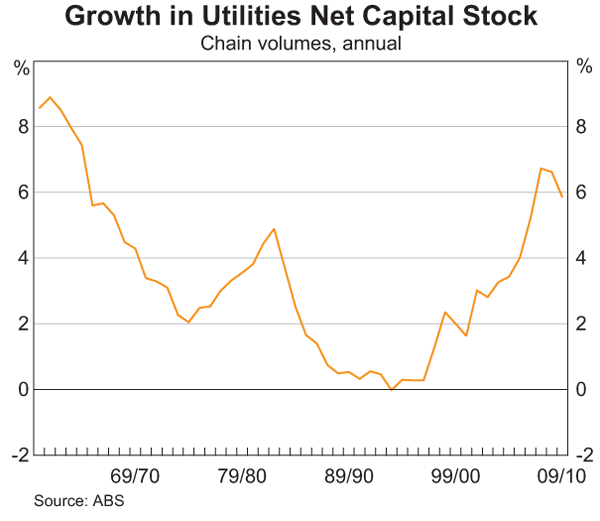
For electricity, investment in transmission and distribution networks has increased sharply in recent years and is expected to remain high for quite some time (Graph 4). This partly reflects the need to replace ageing assets, given that a sizeable proportion of the electricity network infrastructure in Australia was built between the 1950s and 1970s and is coming to the end of its technical life. Investment has also been driven by the need to expand network capacity. This is partly in order to satisfy strong growth in demand for electricity at peak times, particularly due to the greater use of air conditioners and heaters on the hottest and coldest days of the year. Network providers need to ensure they have the capacity to meet this peak demand, even though this extra capacity will be idle during non-peak periods. Moreover, growth in peak demand is expected to outpace growth in overall electricity consumption, which implies that the additional costs involved in expanding capacity will not be matched by increased sales overall, leading to higher prices per unit of electricity sold. Expansion has also been required to meet more stringent reliability standards.
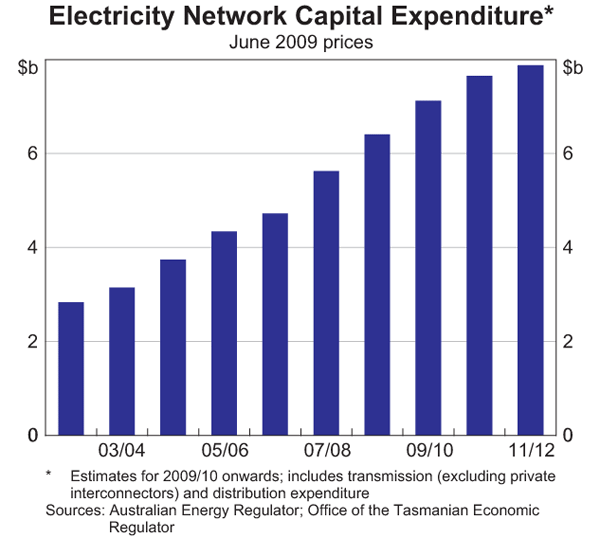
Under the pricing model used by the AER, an increase in investment contributes to higher prices in the regulatory period, as network prices are set to cover an ‘annual revenue requirement’, which consists of ‘regulatory depreciation’ (through which firms recoup the cost of capital expenditure over the life of an asset), as well as a ‘return on capital’, operating expenditures and tax liabilities. Recently an increase in the assumed return on capital, which takes into account borrowing costs, has also contributed to utilities price increases. Most recent price determinations were made in 2009 and 2010 – during and following the financial crisis – when the cost of debt was higher than when previous regulatory decisions were made in the mid 2000s.
In contrast to investment in transmission and distribution networks, investment in electricity generation capacity has been more modest over the past decade. Generation capacity in the NEM (excluding wind) has increased at an annualised rate of about 1¼ per cent over the past five years, broadly keeping pace with the increase in peak demand for electricity (Graph 5). However, there will be a need for increased generation investment in coming years, with current capacity and committed capacity expansions sufficient to meet demand and reliability standards until 2013/14.[7] If future investment in supply capacity is insufficient, this would put pressure on spot prices, and eventually household electricity prices.
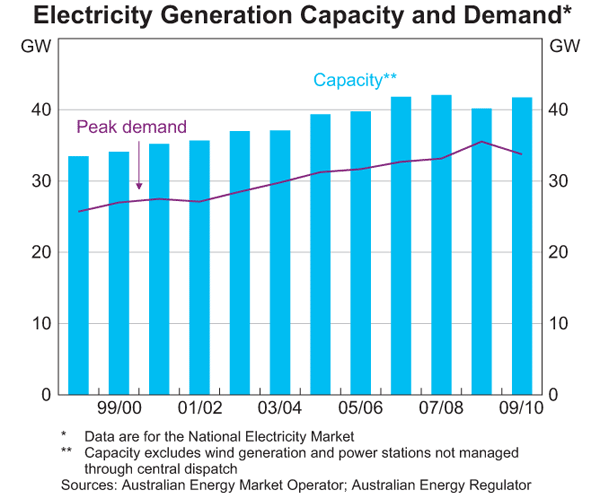
A large amount of investment in gas transmission and distribution infrastructure has occurred over the 2000s, and more is expected. Investment in gas distribution networks in particular has been considerable, and has typically involved upgrading and expanding existing networks and extending networks into new areas.
Significant investment in water infrastructure has also been undertaken and further investment is planned, to secure a more stable water supply (Graph 6). Throughout most of the 2000s, water supply was affected by drought. Water storage levels fell noticeably across most of the country, despite demand management contributing to an easing in usage per household. For example, storage levels in Melbourne fell from 80–90 per cent of capacity throughout the first half of the 1990s to around 30–40 per cent in the late 2000s. Similarly, Sydney storage levels would have fallen to less than 15 per cent of capacity in 2007 had water not been diverted from the Shoalhaven river system. Significant investment in desalination plants has been undertaken, as has investment in recycling plants and water grid infrastructure. To date, three desalination plants have been constructed, and more are expected to be completed in the next three years. Once these projects are completed, the Water Services Association of Australia (2010) estimates that 35 per cent of capital city water needs will be supplied by desalination (based on 2008/09 consumption).
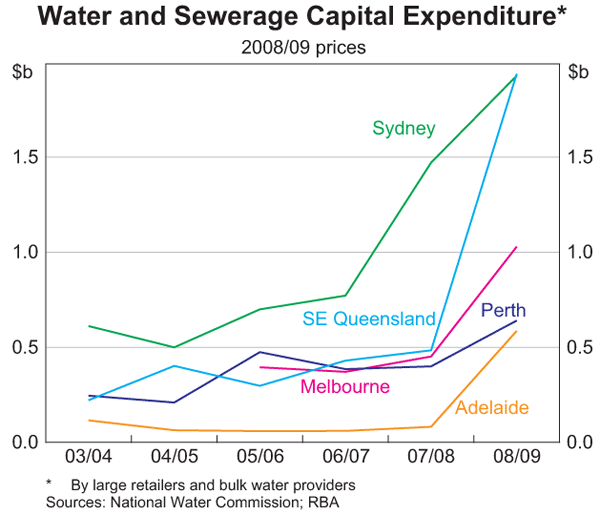
Rising input costs
The drought not only led to upward pressure on water prices, but also affected electricity prices. The drought contributed to a pick-up in wholesale electricity prices from early 2007 by reducing supply from hydro-electric generators and coal generation plants (because of a lack of water for cooling). Coinciding with this, demand for electricity rose very sharply in some states due to extremely hot weather. A combination of high demand and drought-constrained supply led to an increase in wholesale electricity prices in the NEM from the decade average of around $40 per megawatt hour to over $50 per megawatt hour in 2006/07, contributing to the increase in household electricity prices around that time (Graph 7). Over the past few years, wholesale electricity prices have generally eased in most states.
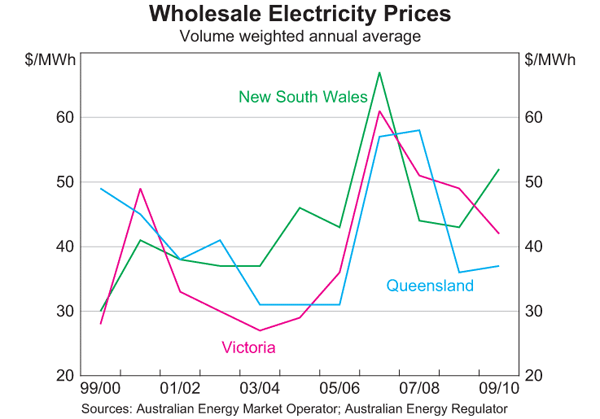
A notable feature of the wholesale electricity market is the volatility in prices, which is masked by the annual averages quoted above. In Victoria, for example, average daily prices have reached more than $2,300 per megawatt hour on certain peak days (Graph 8). At times during peak trading intervals, spot prices even occasionally reach the NEM price cap (which increased from $10,000 per megawatt hour to $12,500 per megawatt hour in mid 2010). Wholesale electricity providers use financial market instruments to hedge against these extreme price movements.
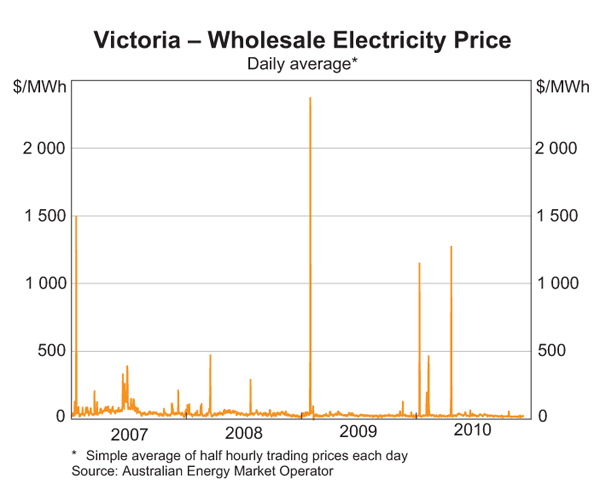
In some cases, utilities prices have also been affected by rising input costs for generation fuels, including gas and coal, although this is yet to lead to a broad-based increase in wholesale prices. In the case of electricity, wholesale providers have typically paid significantly less than the global commodity price for these inputs. Reasons for this include the use of long-term contracts, the use of non-exportable coal (which is lower-grade and therefore cheaper) in the generation process, and vertical integration, which allows generators in some states to source coal from their own mines. In addition, higher prices for commodities such as steel have increased the costs associated with infrastructure replacement and expansion.
The Impact on Inflation
Direct effect
With an effective weight of over 4 per cent in the CPI – of which electricity accounts for around half, and gas & other household fuels and water & sewerage account for roughly a quarter each – large changes in utilities prices can have a significant effect on aggregate inflation. As an example, utilities prices boosted CPI inflation by ½ percentage point over the year to June 2010 (the recent peak in utilities price inflation), relative to a counterfactual where they had grown in line with the rest of the CPI.
Another counterfactual is how CPI inflation would have evolved over the inflation-targeting period had the increase in utilities prices been distributed uniformly over this period, rather than concentrated in recent years.[8] Since 1993, the average annual increase in utilities prices has been around 4 per cent, which is higher than that observed in the 1990s, and lower than that seen in the 2000s. Assuming annual utilities price inflation of 4 per cent each year, rather than the observed outcomes, would have generated a somewhat different profile for aggregate inflation. Prior to 2000, year-ended CPI inflation would have been around 0.1 percentage points higher on average, had utilities price inflation been evenly distributed since 1993. The maximum effect would have been over the year to March 1996, when CPI inflation would have been nearly 0.4 percentage points higher (Graph 9).
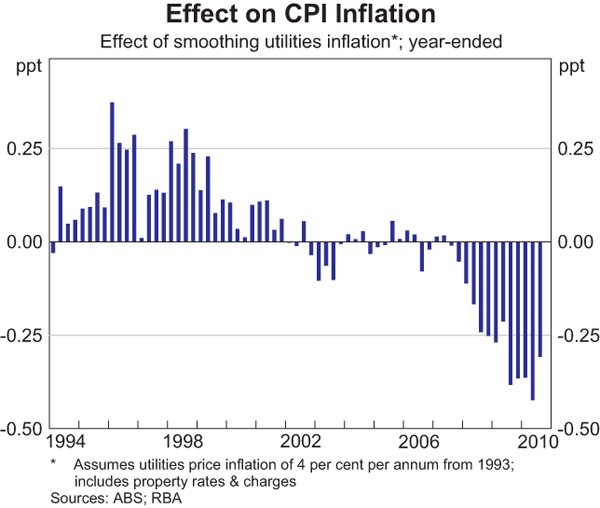
Since 2000, year-ended CPI inflation would have been around 0.1 percentage points lower on average, had utilities price inflation been evenly distributed through time, with the effects most pronounced in recent years. The maximum effect would have been over the year to June 2010, when CPI inflation would have been more than 0.4 percentage points lower than the actual outcome.
The effects on underlying inflation of distributing utilities price inflation evenly through time are smaller, but still significant; on average over the past five years, year-ended trimmed mean inflation would have been a little over 0.1 percentage points lower, with a maximum effect of ¼ percentage point over the year to September 2010 (Graph 10).[9]
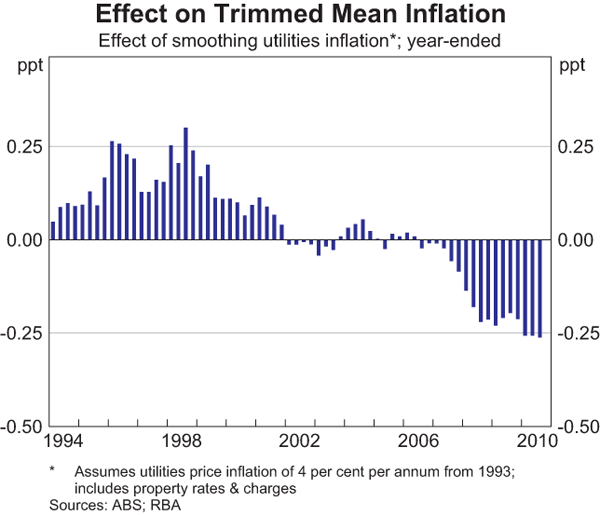
Indirect effect
There is also some evidence of indirect or second-round effects of utilities prices on inflation, whereby the impact of high utilities price inflation on input costs has subsequently led to higher inflation in other goods and services. Estimates based on both econometric work and input-output tables suggest that a 10 percentage point increase in utilities price inflation is associated with a 0.3–0.4 percentage point increase in underlying inflation, over and above the direct effects. This implies that the above-average utilities price increases over the past few years could have contributed around 0.1 percentage points per year (on average) to inflation via the effect on the prices of other goods and services, in addition to the direct effects outlined above. Below-average utilities price increases during parts of the 1990s would have had the opposite effect (albeit smaller), all else equal.
Cross-country Comparison of Electricity and Gas Prices
The increases in Australian household electricity and gas prices since the 1990s have been towards the upper end of the range recorded in advanced economies, and in recent years have mostly outpaced those in other advanced economies (Tables 2 and 3). Wholesale electricity and gas prices fell noticeably in a number of advanced economies during the recent global downturn, partly due to a decline in demand from industrial customers and, in the case of gas, an increase in supply. This placed downward pressure on prices faced by households. In contrast, wholesale prices in Australia were less affected – consistent with the milder downturn in demand and other reasons discussed above – while network costs increased significantly (particularly for electricity).
| Average annual inflation Per cent |
Household electricity price(a)
Share of income per capita |
|||
|---|---|---|---|---|
| 1990–1999(b) | 2000–2009 | Year to latest | 2009 | |
| Australia(c) | 1.6 | 5.0 | 12.4 | 2.8 |
| Canada | 3.3 | 2.5 | 8.1 | 1.9 |
| France | na | 0.8 | 3.1 | 2.8 |
| Germany | 0.7 | 4.5 | 3.3 | 6.3 |
| Japan | −0.7 | −0.8 | 3.0 | 5.1 |
| United Kingdom | −2.8 | 6.0 | −0.4 | 5.6 |
| United States | 0.9 | 4.2 | 0.6 | 2.6 |
|
(a) Price per 10 MWh, in local currency; where 2009 price level data were
not available, the latest available data were extended to 2009 using CPI
electricity prices; United States price includes tax Sources: ABS; International Energy Agency; RBA; Thomson Reuters |
||||
| Average annual inflation Per cent |
Household natural gas price(a)
Share of income per capita |
|||
|---|---|---|---|---|
| 1990–1999(b) | 2000–2009 | Year to latest | 2009 | |
| Australia(c) | 2.4 | 5.3 | 9.8 | 1.2 |
| Canada | 4.4 | 2.3 | 10.6 | 0.9 |
| France | na | 5.2 | 13.8 | 1.6 |
| Germany | 0.0 | 6.2 | 0.8 | 1.8 |
| Japan | 1.1 | 1.2 | 4.3 | 3.6 |
| United Kingdom | −1.1 | 9.7 | −5.6 | 2.1 |
| United States | 1.8 | 5.0 | 1.9 | 1.0 |
|
(a) Price per 40 gigajoules, in local currency; where 2009 price level data
were not available, the latest available data were extended to 2009 using
CPI gas prices; United States price includes tax Sources: ABS; Australian Gas Association; International Energy Agency; RBA; Thomson Reuters |
||||
Despite the large increases in Australian household electricity and gas prices, the level of these prices in Australia does not appear to be particularly high relative to other advanced economies. While it is difficult to directly compare prices across countries (for example, due to exchange rate effects), one approach is to calculate how much it costs to consume a certain amount of energy as a share of average income (measured as GDP per capita). In Australia, it is estimated that 2.8 per cent of average income was required to purchase 10 megawatt hours of electricity in 2009. While this share is more than in Canada and the United States, it is less than in Germany, the United Kingdom and Japan. In terms of gas, around 1.2 per cent of average income was required to purchase 40 gigajoules of gas in 2009 in Australia. Again, this share is more than in Canada and the United States, but less than in Japan, the United Kingdom, Germany and France. These differences in utilities price developments across countries reflect a number of factors, such as demand conditions, market structure, regulatory arrangements, resource endowments and the mix of generation technologies.
Conclusion
Large increases in the prices of utilities have been a notable feature of consumer price inflation in Australia in recent years, and further large increases are anticipated over the next few years. This follows subdued outcomes through most of the 1990s. The recent price rises reflect a range of factors, including the move towards cost-based pricing, the need to significantly increase investment to replace and expand infrastructure, and rising input costs. The direct impact of utilities price increases on aggregate inflation has been significant, and there is also some evidence of indirect effects, whereby rising utilities prices have led to higher input costs for firms, and eventually higher inflation in other goods and services. Inflation in Australian household electricity and gas prices since the 1990s has been towards the upper end of the range recorded in advanced economies, particularly over the past couple of years. Despite these increases, the level of electricity and gas prices in Australia does not appear to be particularly high compared with prices in a number of other advanced economies.
Footnotes
The authors are from Economic Analysis Department. [*]
For a more detailed discussion of these issues, see Australian Energy Regulator (2009, 2010). [1]
Standard contract prices for electricity are regulated in all states except Victoria. Standard contract prices for gas are regulated in New South Wales, South Australia and Western Australia. [2]
A price cap of $12,500 per megawatt hour exists in the NEM. Note that Western Australia and the Northern Territory are not part of the NEM. [3]
Prices in Western Australia are regulated at the state level, rather than by the AER. [4]
For a more detailed discussion of these issues, see Australian Energy Regulator (2009, 2010). [5]
This unwinding began in the 1990s, with larger real falls in electricity prices for businesses than for households. [6]
For more information, see Australian Energy Market Operator (2010). [7]
To avoid a series break in this counterfactual exercise, utilities includes property rates & charges, which were grouped with water & sewerage prior to September 1998. Series are adjusted for the tax changes of 1999–2000. [8]
This assumes that the rest of the price distribution was unchanged. [9]
References
Australian Energy Market Operator (2010), ‘2010 Electricity Statement of Opportunities for the National Electricity Market’, Planning Report.
Australian Energy Regulator (2009), State of the Energy Market 2009, Australian Competition and Consumer Commission, Canberra.
Australian Energy Regulator (2010), State of the Energy Market 2010, Australian Competition and Consumer Commission, Canberra.
Water Services Association of Australia (2010), ‘WSAA Report Card 2009-2010: Performance of the Australian Urban Water Industry and Projections for the Future’, Water Industry Report Card.